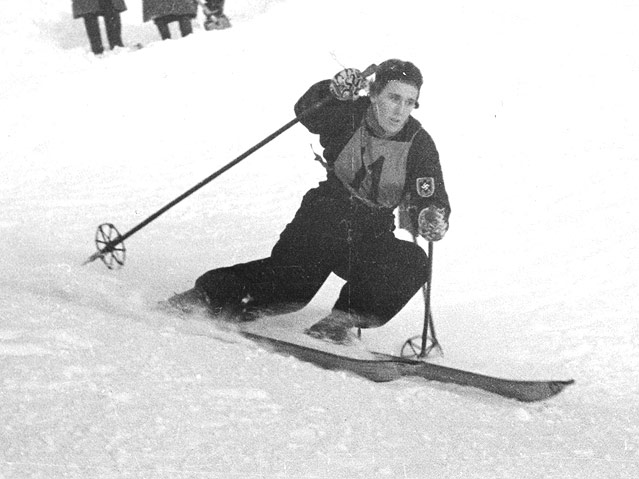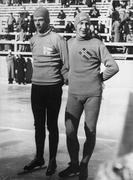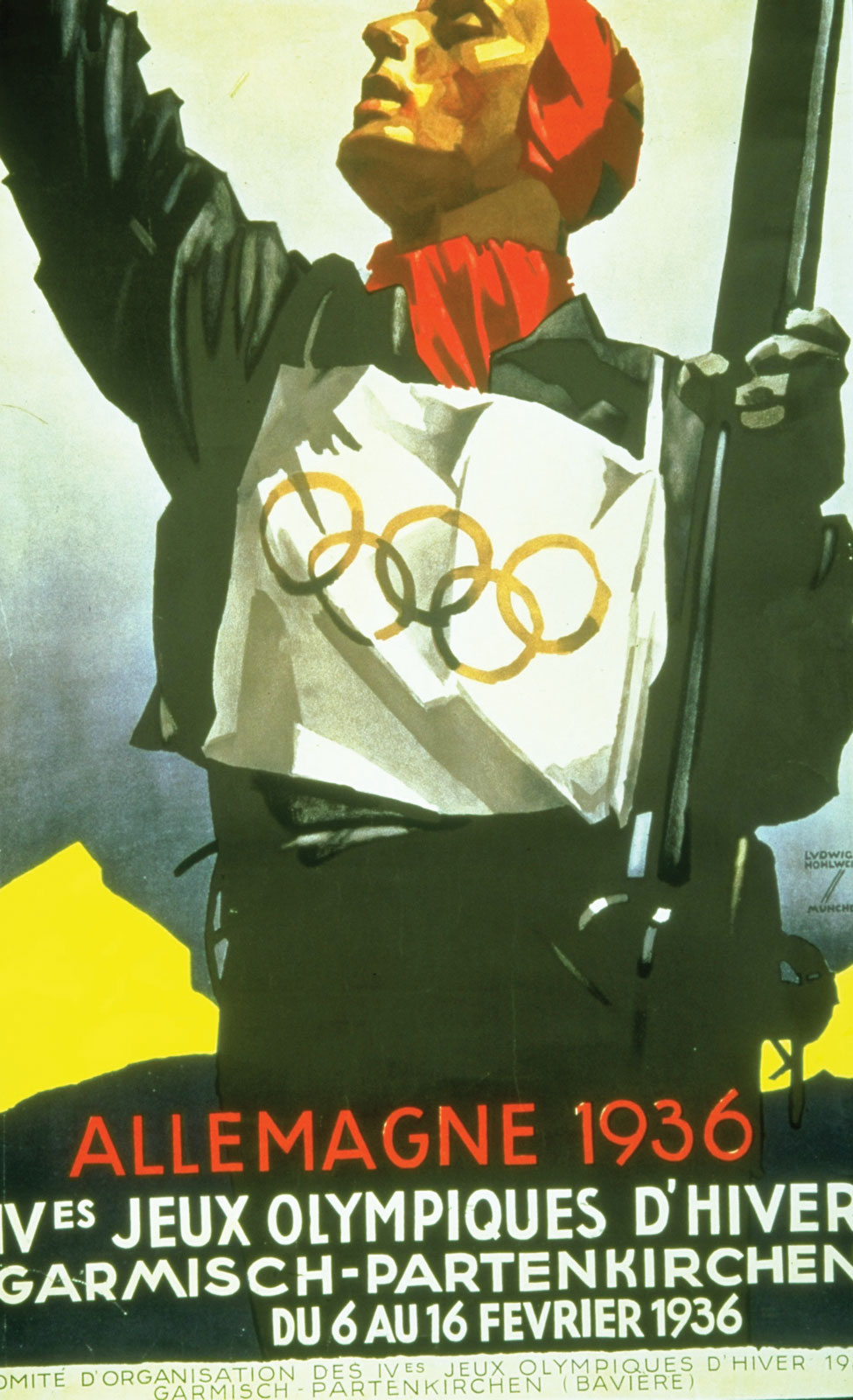As with the 1924 and 1932 Winter Olympic Games the IOC approached the nation that was hosting the Summer Games of 1936 about hosting of the Winter Games. The twin-town Bavarian resort of Garmisch-Partenkirchen, right down by the Austrian border was chosen.
Competitors 646 (+282)
Nations 28 (+11)
Events 17 (+3)
Sports 6 (+1)
6 February to 16 February 1936 hosted by Garmisch-Partenkirchen, Bavaria, Germany
New nations to take up the Winter Olympic cause were Australia, Bulgaria, Greece, Liechtenstein, Spain and Turkey.
Australia though only officially represented by Ken Kennedy in the speed skating, coming in the 30s in the 500m, 1500m and 5000m, actually had another representative. Frederick McEvoy was representing Great Britain in the bobsleigh, he actually carried the Union Flag in the opening ceremony. He went on to take bronze in the four-man and just missed out in 4th place in the two man event.
Bulgaria with a team of six took part in both the Alpine and Cross Country Skiing, more successfully in the latter as they DNF or were disqualified in the alpine events. Their men came 15th in the 4x10km relay and all four completed the 18km race. Greece sent one man Dimitrios Negrepontis who actually took part in the Alpine Combined and 18km Cross Country. However, he was disqualified in the second run of the slalom in the combing and did not finish in the cross country.
Liechtenstein despite being the smallest of the new nations actually sent four athletes. Two in the Alpine Combined who also failed in the second run of the slalom, and a two man bob team who finished 18th out of the 23 crews. Spain sent two women in the Alpine Combined, one didn't start the slalom and the other fell foul on the second run., and four men in the cross country 18km.
Turkey sent six men, four of whom took part in the Alpine Combined, one of those Mahmut Şevket was one of the two who took part in the 18km Cross Country, with another and the other Alpine crossover Reşat Erceş they entered but did not finish the 4x10km relay. Indeed only Şevket finished any of his events, he was the 72nd and last finished in the 18km Cross Country though he was 25 minutes behind the Brit Francis Walker who was 71st and just two seconds shy of 55 minutes behind gold medallist Erik August Larsson of Sweden.
Let's ski downhill
 |
| First Alpine Olympic champion Christl Cranz |
Unlike the Nordic which went uphill, downhill and along on the flat, this was all in a downhill direction, it had been around as a sport since 1861. The event debuted with two combined events one for men and the other for women.
Both events were dominated by the Germans who took gold and silver in both. But with the women's Slalom happening on February 8th completing their event a full day before the men's Christl Cranz, who was born in Belgium,becoming the first Olympic Alpine champion. She had only been 6th after the Downhill on the 7th, but her superior slalom skills took her to the top of the field. She came ahead of her compatriot Käthe Grasegger and Norway's Laila Schou Nilsen.
In total from 1934 until the out break of World War II in 1939 Cranz had won twelve world championships, five combined, four in slalom and three in downhill, when she hadn't won in the individual disciplines she had won silver. In a German friendly only 1941 World Championships in Cortina d'Ampezzo, she won a final clean sweep and then retired. Her younger brother had finished 6th in the men's event, but ended up being killed on his first day in action on the Eastern Front 22 June 1941.
In that men's event Birger Ruud of Norway had lead after the Downhill put all three of the men who were behind him moved up one spot to assume the medal spots. Germans Franz Pfnür and Gustav Lantschner while in bronze came Frenchman Émile Allais. Allias was to live to see his 100th birthday on 25th February 1912, but when he died on 17th October last year no pre-war Winter Olympic medalist was still alive.
No success in Alpine but...
 |
| Birger Rudd retains his Olympic title |
With two world championships and as the defending champion Birger came into the 1936 Games as the favourite. Although Sweden's Sven Eriksson managed to jump 76 metres in both rounds to Ruud's 75 and 74.5 metres it was the Norwegian's style points that saw him retain his Olympic title.
He was to return in 1948 at the age of 36 for his third Olympics and managed a silver medal behind another Norwegian, maintaining their record of being the only nation to win the ski jumping, indeed a record they would retain until 1956.
Shock in the Ice Hockey
 |
| Great Britain beat Canada twice to earn gold in Ice Hockey |
In the first round unsurprisingly Canada came through their group unbeaten, as did Czechoslovakia and Great Britain in their groups. In the other the hosts lost the group opened to the USA, but went won their other two. But the USA suffered a shock loss in double overtime to the Italians who if they had beaten Switzerland the following day could have knocked out the USA behind themselves and the Germans if they scored enough goals. Fortunately the USA made it through to the second round avoiding embarrassment.
In that second round the Great Britain team stared with by beating the Canadians and then tying with the Germans to top their group. The Canadians had won their other two games and made it through to the final group. While in the other Group USA won all three of their games and were joined by Czechoslovakia in the final.
In the final round yet again Great Britain faced Canada in the first game and yet again won, before beating the Czechs 5-0. In their third Game they were up against the USA. The USA had a final game the next day against Canada so a win here would have given them a change of taking gold even if they only managed a tie in the last game. But instead the two nations played the longest goalless game in Winter Olympic history, nobody scoring in the three periods or three of overtime.
It meant that the last game that was supposed to be the gold medal match between the USA and Canada was only for silver Great Britain with 5 points could only be equaled on points by the USA but would have to have beaten Canada by 5 clear goals to secure gold. As it was the fresher Canadians won 1-0 to take silver.
Triple for Ballangrud
 |
| Ballangrud right and Wasenius |
The man who seemed to benefit the most was Norway's Ivar Ballangrud. Having come away with a single silver four years before he came away with golds in the 500m, 5000, and 10,000m, in the latter two setting new Olympic records and in the first equaling the existing mark. He was to add a silver in the only other event the 1500m, despite beating the previous Olympic record to his fellow Norwegian Charles Mathiesen.
The next most successful skater of the event was Birger Wasenius of Finland. He took silver in both the longer disciplines and bronze in the 1500m. He was used to coming second behind Ballangrud, indeed four of his six world or Olympic silvers were to be behind the Norwegian. However, at the end of the Games when the call goes out for the young people to assemble in four years hence little did the Finn realise that because of the Winter War between Finland and Russia in 1939-40 that he would be killed in action fighting on the islands of Lake Ladoga on the 2nd January 1940.
Jumping for gold
| Herber and Baier about to take off |
The pair were to retire in 1940 and then got married. They had three children together before getting divorced in 1964. Ernst married another figure skater who was only 3 months old when they won their Olympic medal but that marriage only lasted 8 years before he remarried Herber before again divorcing.
Elsewhere in the figure skating Sonja Henie Norway completed in her fourth games winning her third consecutive gold. Although it wasn't to be plain sailing for the Norwegian this time. Great Britain's Cecilia Colledge ran her close in the compulsory figures and when Henie saw the scores posted on the board apparently whipped them down and tore them up. In the free skating programme Henie was to go last while her close rival was second out of the 26 skaters to have to perform before the crowd were warmed up into a frenzy and the judges usually became freer with high scores later on. There was controversy over this perceived favouritism and in later events the staggered draw putting the top competitors together in the last group was adopted to avoid too much shadow of doubt about fairness.
Always the bridesmaid
 |
| Reto Capadrutt driving |
The four man event took place first on the 11th and 12th of February. On day one he drove his team Switzerland I to a time of 1:23.49 on the first run. This put them behind Germany I on 1:20.73, Belgium II 1:22.22, Switzerland II 1:22.45 and Great Britain I 1:23.48. The second run of the day saw them record 1:19.88, it was only bettered by their fellow countrymen in 1:18:78 and USA I on 1:19.17. It was enough with Germany I only recording 1:23.05, Belgium II 1:23.52 and Great Britain I 1:20.18 to move them up to second place some 0.19 of a second ahead of Great Britain I and 0.41 ahead of Germany I.
On day two the British team took 0.01 off that lead on the first run but the Germans had a disaster losing over 3 seconds. Switzerland II however gained another 0.85 seconds to lead by over 3 seconds going into the last run. On that last run USA I were the fastest a mere 0.07 seconds faster than Capadrutt had driven his crew. He secured another Olympic silver behind his fellow country men.
The 14th and 1th were a disaster for him in the two man event, on run three alone he lost 10 seconds to his fellow Swiss who were fastest on the last three runs but didn't do enough to overhaul USA I's lead from the first. It meant that in a total of 16 legs in the tow Olympic disciplines he had only been fastest down in one run the first of the two men runs in 1932, secured two silver medals and a fourth place.
In the 1939 World Championships the last before the outbreak of war disaster struck as in the four man event he was killed while competing at the age of 27. He was never to get a chance to go one step higher on the Olympic podium.
We will remember them...military patrol
There were rumours of Europe being on the brink of war and the men who took part in the 1936 Military patrol knew full well that if war were to come they would be some of the first to quite literally face some of their competitors when there was more than Olympic medals on the line. This precursor to the biathlon was still a demonstration sport and open only to serving soldiers therefore in a few short years many of these competitors would see their Olympic skills tested in the field, their skiing and shooting not for glory for for preservation. Unsurprisingly many failed to live to see the next Olympic Games.
 |
| The gold medal winning Italians |
Silver medal winning Finland suffered hard, their military was thrown into a winter war against the Soviet Union in 1939 which claimed two of their number Kalle Arantola on 12 February 1940 and a week later Olli Huttunen, the third non-officer Olli Remes died in East Karelia during the continuation war on New Year's Eve 1942.
The officer of the 5th placed German team Herbert Leupold was killed on the Eastern Front in the North Caucasus region of Krasnodar Krai on 22 December 1942. He had the rank of Lieutenant at the time of the Games.
But some survived with honour.
French officer Jacque Faure survived the war serving in Norway, as attaché to de Gaulle's General Staff in London, before being sent back to France. He rose to the rank of General. During the Algerian War in 1954-62 he planned a coup against the French Government in North Africa in 1956.
Polish officer Władysław Żytkowicz was active during the German invasion of his country in 1939, he retreated with his troops into Romania after the Soviet Union also invaded Poland as a ally of Germany at the time. From there he made his way to French administered Syria where surviving Polish troops regrouped at the Independent Carpathian Brigade. When the French capitulated to the Germans he moved to British controlled Palestine. He saw action at Tobruk and in the Italian Campaign and at the end of the war smuggled his family out of Soviet occupied Poland to Italy, from where the Polish troops returned to Britain for demobilisation and from there settled in the USA.

No comments:
Post a Comment